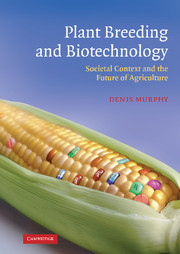Book contents
- Frontmatter
- Contents
- Preface
- Acknowledgements
- Using this book
- Nomenclature and terminology
- Abbreviations and glossary
- Introduction
- Part I The science of plant breeding
- Part II The societal context of plant breeding
- Part III Turmoil and transition: the legacy of the 1980s
- Part IV The agbiotech paradigm
- 11 Agbiotech: genes and dreams
- 12 The future of transgenic crops I: improving the technology
- 13 The future of transgenic crops II: improving the products
- Part V Increasing global crop production: the new challenges
- Part VI Plant breeding in the twenty-first century
- Notes
- References
- Index
13 - The future of transgenic crops II: improving the products
Published online by Cambridge University Press: 07 May 2010
- Frontmatter
- Contents
- Preface
- Acknowledgements
- Using this book
- Nomenclature and terminology
- Abbreviations and glossary
- Introduction
- Part I The science of plant breeding
- Part II The societal context of plant breeding
- Part III Turmoil and transition: the legacy of the 1980s
- Part IV The agbiotech paradigm
- 11 Agbiotech: genes and dreams
- 12 The future of transgenic crops I: improving the technology
- 13 The future of transgenic crops II: improving the products
- Part V Increasing global crop production: the new challenges
- Part VI Plant breeding in the twenty-first century
- Notes
- References
- Index
Summary
To improve is to change; to be perfect is to change often.
Winston Churchill (1874–1965) attributedIntroduction
For almost twenty years, the appearance of a large number of sometimes radical new transgenic crop traits has supposedly been just around the corner, but none of these ‘wonder products’ has yet made it to large-scale commercial cultivation. One of the commonest criticisms of the agbiotech industry is that a few companies precipitously commercialised a narrow set of relatively trivial input traits in the mid-1990s, rather than waiting to develop a wider range of consumer-friendly product traits. In this chapter, we survey the new generation of transgenic traits now being developed, their prospects for success, and some possible alternative non-transgenic strategies to generate the same traits in commercial and subsistence crops. We will consider two categories of traits, namely: input traits, which affect how the crop is grown without changing the nature of the harvested product; and output traits, which change the quality of the crop product itself, e.g. by altering starch, protein, vitamin or oil composition.
Input traits
Almost the entire current portfolio of commercial transgenic crop varieties contains modifications to either or both of just two input traits: herbicide tolerance and/or insect resistance. However, these two examples are far from the most important yield-limiting input traits in most farming systems around the world. More important yield traits relate to other types of biotic (from other living organisms) or abiotic (from the non-living part of their environment) stresses encountered by plants.
- Type
- Chapter
- Information
- Plant Breeding and BiotechnologySocietal Context and the Future of Agriculture, pp. 189 - 210Publisher: Cambridge University PressPrint publication year: 2007



